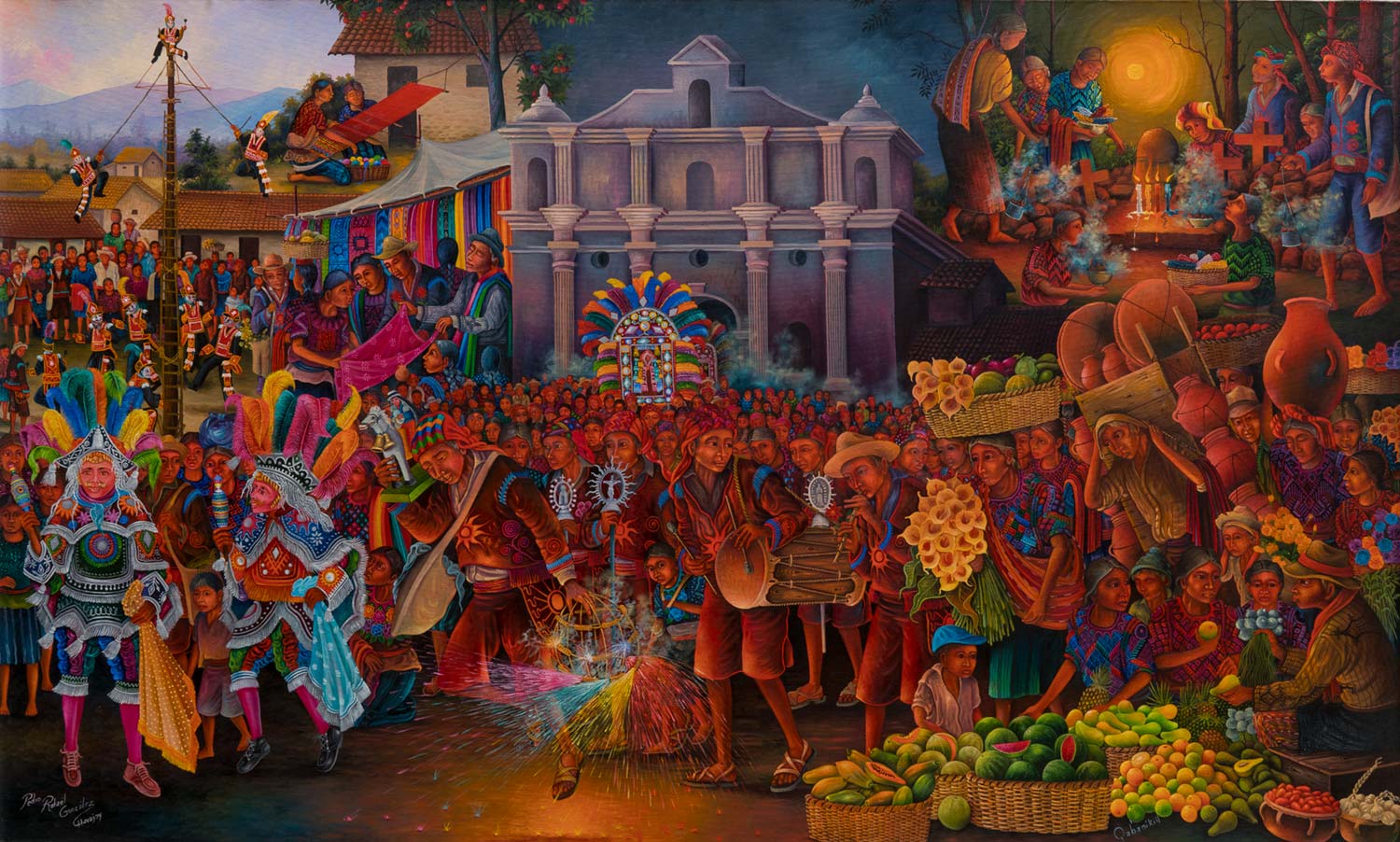In this painting, Pedro Rafael depicts important traditions of Chichicastenango—some pre-Hispanic Maya, others a hybrid of Maya and Catholic beliefs and traditions. The Popol Wuj, the pre-Hispanic creation story and history of the K’iche’ Maya, was recorded in the town of Chichicastenango. One cannot overstate the importance of the Popol Wuj, which is one of very few documents that eluded destruction at the hands of Catholic priests.
In the center of the painting, the Catholic church of Santo Tomas rises above a large crowd. At the front of this procession is a dancer carrying a wooden frame with a small, colored pyrotechnic display. On his shoulder he carries the sculpture of a man on a horse, the Tzijolaj. This is a mythic figure, born in the hybridization of indigenous culture and tradition, who leads the way to a peaceful life. The dancer is a cofrade, a member of a religious guild, and he is accompanied by two musicians, one playing a drum, el tambor, and the other a flute, la chirimilla. Members of other cofradias follow, carrying varas, their staff of office and authority. Behind them in the middle of the crowd, men carry images of Santo Tomas and other saints. These images are adorned with brightly colored feathers which represent the rays of the sun emanating from these saints. Smoke from incense, pom, rises in front of the church.
The market in Chichicastenango is famous throughout Guatemala. It is especially well known as one of the best places to buy handwoven textiles and traditional Maya clothing, traje. This market takes place on Thursdays and Sundays in the plaza in front of the church. In the painting we see a stall of weavings to the left of the church. In the background above the stall, two women sit outside an adobe house. One is weaving fabric on a backstrap loom; the other is working with the wool, cotton, or silk balls used in the weaving. Fruits and vegetables are also sold at the market, and these are represented in the lower right-hand corner of the painting. Vendors also sell flowers and earthenware pottery. Several women carry produce or pottery to the market on their heads, and a man carries his wares in a kakaxte, a wooden cage to protect the pottery during the trek to Chichicastenango. The patterns of the huipiles, traditional blouses worn by the women, indicate that they may have travelled from Maya communities outside of Chichicastenango.
On the left-hand side of the painting are represented two of the masked dances which are performed at town festivals and on holy days. In the foreground, two elaborately dressed men wearing plumes and capes represent Spaniards in the Dance of the Conquest. This dance recalls the story of how the Spanish defeated the Kiche king, Tecum Umam—who never surrendered. Behind them we see another masked dance, the Palo Volador (Birdman) which is more of an acrobatic performance than a dance. It is a pre-Hispanic dance which celebrates the winter solstice and the return of the sun.
Finally, in the upper right-hand corner of the painting, an ajq’iij, a Maya spiritual guide, performs a ceremony by the light of the moon at Pascual Abaj. This is one of hundreds of sacred sites outside of the Maya towns in Guatemala, where traditional Maya rituals have been performed in secret for centuries. Since the signing of the Peace Accords, the Maya can no longer be persecuted for practicing their traditional religious beliefs. In spite of these new legal protections in Guatemala, many small Christian sects today continue to demonize ceremonial practices and Maya thought.


